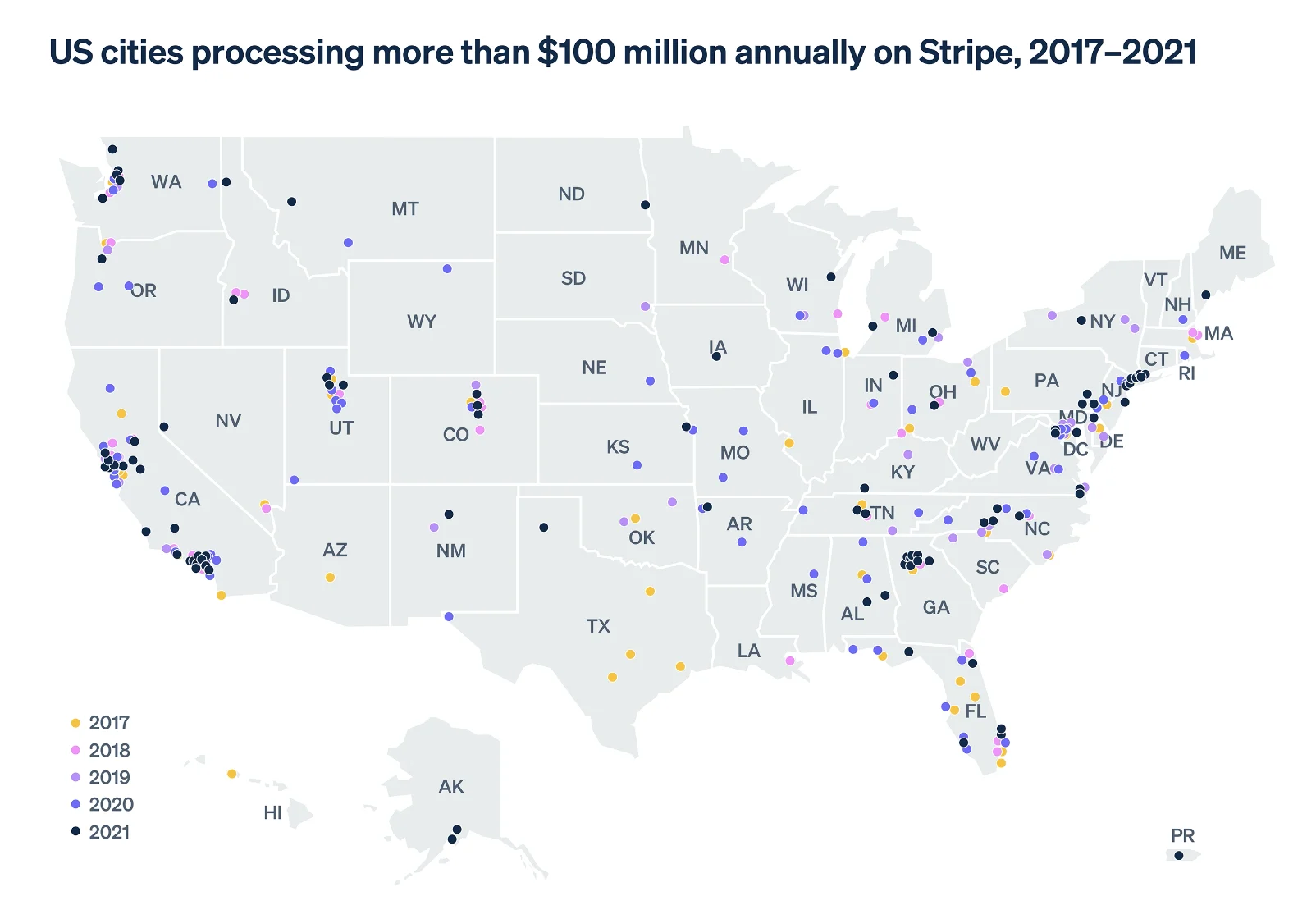The internet economy is everywhere
Technological, economic, and sociological change are expanding access to entrepreneurship at a historic pace.
In 2014, the Bay Area was home to more billion-dollar companies than the rest of the US combined. And for many founders, it was hard to conceive of building an internet business anywhere else.
Not anymore. A diffusion of talent and investment capital, combined with the proliferation of accessible financial infrastructure, has paved the way for the rapid growth of the internet economy beyond traditional tech hubs and major metropolitan areas. Of companies incorporating with Stripe Atlas, 92% are based outside Silicon Valley and 43% are led by first-time entrepreneurs.
Anchorage, Alaska exemplifies the trend. A decade ago it was an unlikely internet economy hotbed. Today, it’s home to thousands of internet businesses that collectively process more than $100 million annually on Stripe. More than 350 other cities across the US have hit that threshold so far this year—from Bend, Oregon to Syracuse, New York. Collectively, their online revenue has increased sixfold over the last five years.
During the current economic slowdown, some cities will struggle to maintain this pace of growth. But the long-term trend is clear: The internet economy is increasingly everywhere, and that distributed growth will be key to the next economic recovery.
Coast to coast
Over the last five years, internet commerce grew faster in Washington, West Virginia, and Ohio than in any other states in the US. Smaller cities are among those leading the push. During this period, payment volume on Stripe increased 40x in Columbus (Ohio), 20x in Richmond (Virginia), and more than 5x in Atlanta, Charlotte, Denver, Detroit, and Des Moines (Iowa).
But urban areas aren’t doing all the work. Over that same period, rural areas in the US increased processing volume on Stripe sevenfold. They include the five least-populous counties in the US: Kalawao (Hawaii), Loving (Texas), King (Texas), Kenedy (Texas), and Arthur (Nebraska). Combined, these counties are home to 1,400 people, yet they run 39 businesses on Stripe—one Stripe business per 36 people.
"It wasn't on anyone's bingo card five years ago that three Texas counties would be leading the way in internet entrepreneurship. But as new financial infrastructure makes it easier for businesses and founders anywhere to start and scale online, the internet is quickly becoming a powerful catalyst for economic opportunity everywhere,” said Emily Glassberg Sands, head of information at Stripe.
Wider access to the internet economy increased overall US job creation by 12% in 2021, including a 27% increase in rural areas. This includes non-traditional tech centers like Ohio, Alaska, and North Dakota, which saw the greatest percentage increase in jobs fueled by the internet economy.
Anchorage-based Chugach Chocolates has used Stripe to grow their business online since 2019.
Small towns up close
The new face of the internet economy is evident in Glasgow, Montana, which The Washington Post named the most remote town in the country in 2018. Its 3,332 residents live along the Milk River in the northeast corner of the state, four hours from the nearest metro area. More than 40 businesses in Glasgow use Stripe to participate in the online economy, selling everything from phone accessories to craft kits to car parts.
Glasgow’s success is mirrored in other small towns and cities. Ballston Spa, New York has one internet business for every 12 people. In Greenville, South Carolina, the ratio is one business per sixteen people, and the seven-block heart of North Main Street alone is home to nine businesses on Stripe. They include Methodical Coffee, which opened in 2015 and has expanded via both physical locations and online sales, and Worthwhile, which brings software and data solutions to midsize companies across the US.
Global from day one
International sales have been a big part of the expanding internet economy, and the companies seizing this opportunity are based all over the US. New Mexico, Puerto Rico, Kentucky, and Mississippi saw the fastest growth in cross-border transaction volume on Stripe over the past five years. They processed more than $500 million in international sales in 2021 alone, a sevenfold increase compared to five years earlier.
The acceleration is powered by companies like Spine in Puerto Rico, which makes 2D gaming animation software, The Max Letters in Mississippi, a personalized fantasy series for kids, and MPanel in New Mexico, which makes software for use in the architectural tensile structures field. They’re among more than 300,000 US businesses on Stripe with at least 10% of their sales coming from outside the US. More than 125 cities have experienced 10x growth in overseas business, with Covington (Kentucky), San Bruno (California), and Mishawaka (Indiana) topping the list.

These trends reflect the fact that barriers to entrepreneurship have steadily declined over the past decade. Talent and capital are easier than ever to access, and more entrepreneurs in more places are starting businesses as a result.
"This is probably the best time in history to turn an idea into a business," said John Collison, cofounder and president of Stripe. "It's become increasingly clear that what you're building matters more than where you're from, and that's an encouraging sign for founders everywhere."



